Excerpts from Jim Conrad's
Naturalist Newsletter
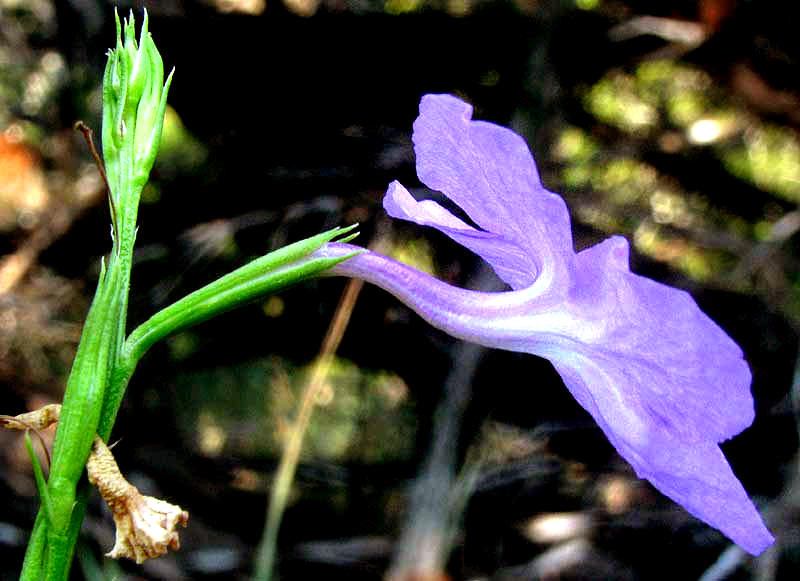
from the September 1, 2013 Newsletter issued from the Frio Canyon Nature Education Center in the valley of the Dry Frio River in northern Uvalde County, southwestern Texas, on the southern border of the Edwards Plateau; elevation ~1750m (~5750 ft); N29.62°, W99.86°; USA
FLAXLEAF BOUCHEA
One reason I liked being in Mexico was that down there the plants are much less known than in North America and Europe. Often I felt that I was making a real contribution by posting photos and information about obscure plants, and that eventually there'd be an expert who would be happy too see what I had. Here in southwest Texas the plants are much better known but, still, on the average, they're not as well studied as plants of most of the rest of North America. Below, you can see a species about which there seems to be a good deal of confusion:
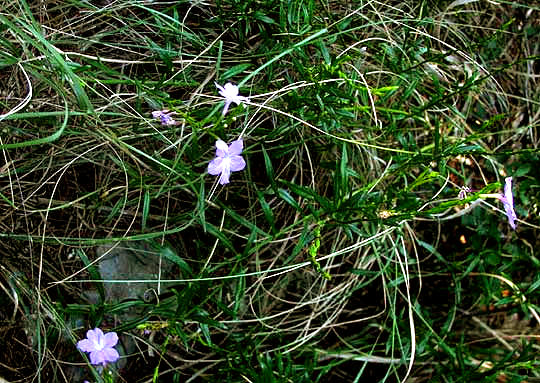
This one almost went unnoticed because it grew in deep shade beneath an Ashe Juniper on the Dry Frio's gravely floodplain, on the downstream side of the trunk where floodwater had swirled around scooping out a depression. The plants' leaves were simple and so slender that they could be confused with grass blades. The inch-broad (2.5cm), light blue flowers seemed to hover just above a tangle of grass.
The flowers' size, color and five rounded lobes spreading flatly atop a slender tube all suggest that we have yet another species of "wild petunia," of which we've seen several during our travels, two here along the Dry Frio. But such narrow leaves are unusual for a wild petunia. It was time to "do the botany."
At the top of this page you can see a side view of the flower showing a particularly long, slender, curved tube arising from a calyx with especially narrow, sharp-pointed sepals. A picture of maturing fruits with their brown, withering styles still attached, and with conspicuous, scale-like bracts subtending each fruit-filled calyx is shown below:
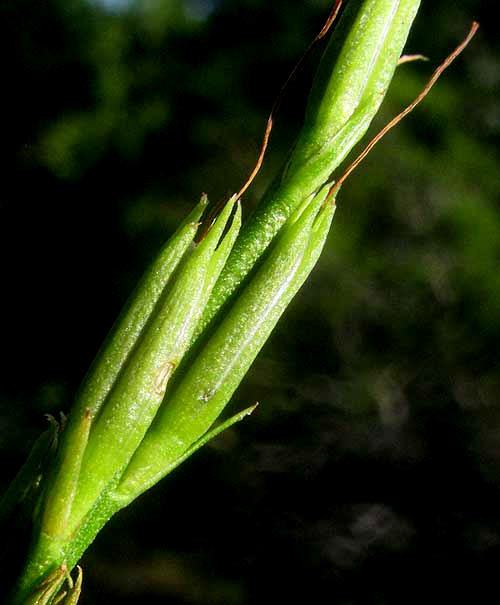
Everything we've seen so far is pure "wild petunia," genus Ruellia of the Acanthus Family. But, what about those leaves? A look at them is provided below:
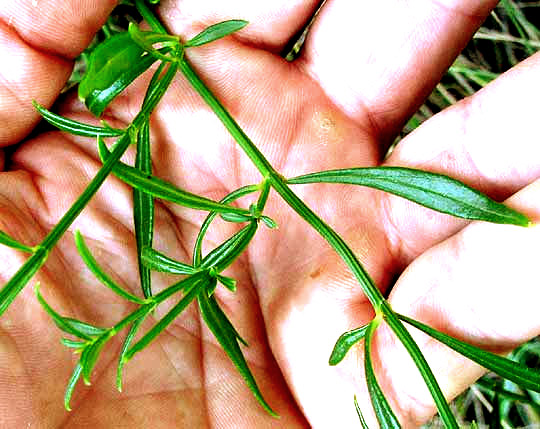
Such narrow leaves are unusual for wild petunias, but there's a cluster of species that does has them, and we have one of those. However, it's not a simple matter of revealing which species it is.
In Shinners & Mahler's Illustrated Flora of North Central Texas our plant keys out to Ruellia malacosperma, of which the authors mention the opinion of Turner, an expert on the group, that R. malacosperma and R. brittoniana are "probably no more than regional population leaf variants of the same species," R. brittoniana having even narrower leaves. And some experts regard R. brittoniana as the same as R. simplex, a Mexican species. In short, the experts are in no agreement as to what to call this species.
Here we'll file it as RUELLIA MALACOSPERMA which, if it really is the same as R. brittoniana, as I also suspect, can be known as the Mexican Petunia. I trust that any future expert looking for pictures and habitat descriptions of either R. brittoniana or R. simplex will know to search under R. malacosperma, too.
from the August 3, 2014 Newsletter issued from the Frio Canyon Nature Education Center in the valley of the Dry Frio River in northern Uvalde County, southwestern Texas, on the southern border of the Edwards Plateau; elevation ~1750m (~5750 ft); N29.62°, W99.86°; USA
ROSANNA FREYRE'S SEEDS
A few months after the above information was published, Dr. Rosanna Freyre, a research scientist in environmental horticulture at the University of Florida, wrote, asking for seeds.
Dr. Freyre wrote during the winter when no seeds were available, so I told her to remind me in a few months. She did, and this week after searching most of a morning I found one plant flowering, shown below:
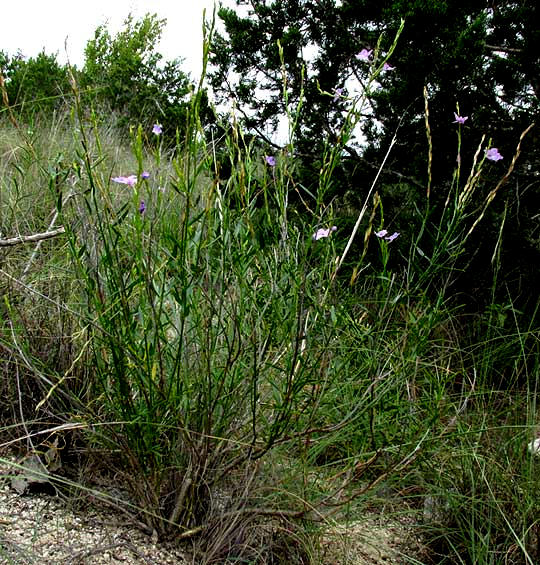
The plant bore both flowers and fruits, shown below:
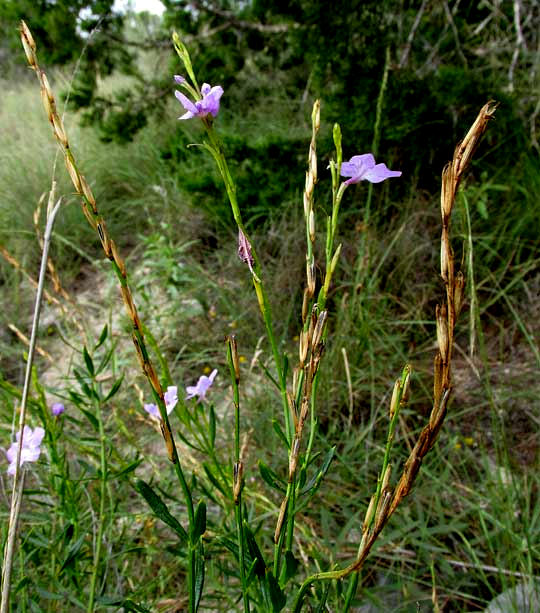
A blackish fruit nestled within dry, brown sepals is shown below:
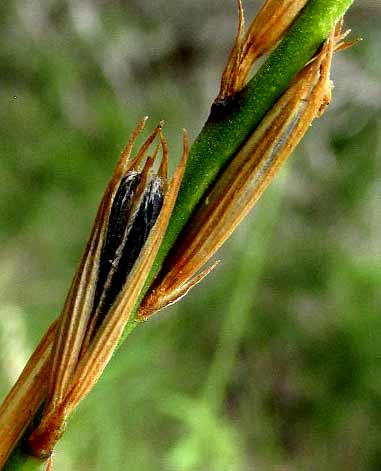
This plant was growing well, bore green leaves and lots of flowers and fruits, much in contrast with other wildflowers here, because of the serious drought. I think the reason this plant looked so good was that it was a woody perennial, probably with deep roots. The woody base is shown below:
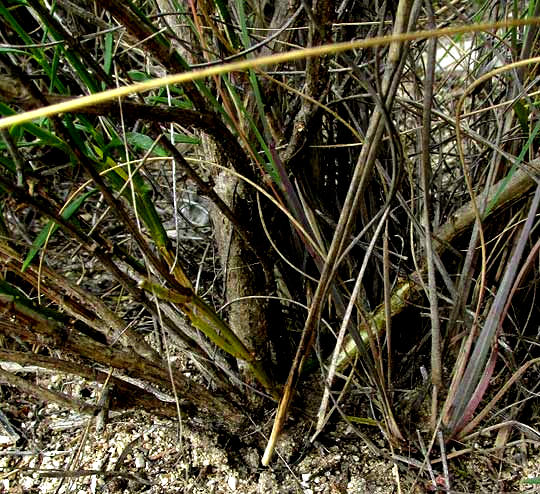
I sent lots of fruits to Dr. Freyre, and I took all these pictures because maybe it'll turn out that our plant will make a good garden plant, or at least contribute some genes to another wild petunia species with bigger flowers, but weak roots.
Whatever the case, I'm always tickled to help researchers like this, and I hope our seeds produce many pretty Mexican Petunias.